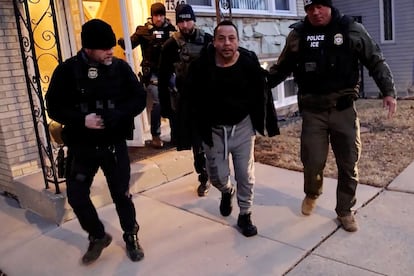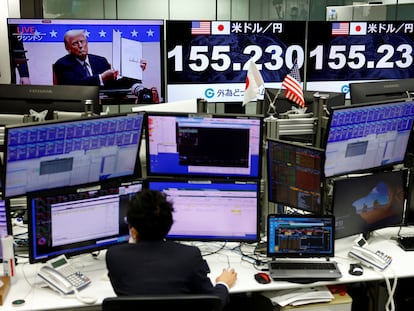Migrants in Chicago after Trump raids: ‘We will continue working, but we are afraid’
The crackdown on illegal immigration underscores the crucial importance of foreign labor to the economy of the city and the state of Illinois


Erika’s trip to Houston to see her children hangs in the balance due to her immigration status: undocumented. The same fate has befallen the parents of Yasmin, whose quinceañera party has been canceled, along with the princess dress and ballroom they had booked months in advance. In La Villita, a neighborhood in South Lawndale, the tire repair shop of Iban — also undocumented — has displayed a closed sign since last week, when the Trump administration launched a large-scale deportation operation targeting irregular immigrants in Chicago. This offensive has thrown the daily lives of tens of thousands into turmoil, creating a limbo of fear and uncertainty.
“But we have to keep going,” says Manuel, a Mexican waiter in a downtown Chicago café. “Raids and the threat of la migra [Immigration and Customs Enforcement, or ICE] are nothing new for us. Of course, we are afraid, but what else can we do? We keep working because that’s why we came here — not to commit crimes.” None of the individuals interviewed in this report wished to give their last names.
Beyond the numbers — 5,500 arrests between January 23 and 29, with a daily average of 800 compared to 300 last year — the operation has underscored several harsh realities. One is an economy deeply reliant on cheap labor. “Here, out of about 20 waiters, most of us are undocumented, and some of us have been working for years,” explains Manuel, who works at a business recommended in some tourist guides that operates largely on the labor of those whom Trump would label “criminals.”
Another reality is the failing immigration system, patched together by temporary fixes rather than lasting solutions. It’s “a broken system” — a term used by both Trump and Democratic candidate Kamala Harris during the election campaign. In families like Bonifacio’s, who works at an electronics factory, there are undocumented immigrants (himself and his wife), children protected as Dreamers under an Obama-era program for those who arrived in the country as minors, and grandchildren who are American citizens thanks to jus soli — birthright citizenship. This is the same right Trump sought to abolish with one of his first executive orders, though a judge temporarily blocked the move.
Bonifacio, who arrived in Chicago 34 years ago with his wife and two young daughters, is now considering returning to Mexico. “I couldn’t go when my parents died because if I left the U.S., I wouldn’t be able to re-enter. But after building a life here, what’s left for us? Living in fear? Hiding? We pay taxes, contribute to the economy, we consume… I don’t have any criminal record, at most a fine for running a red light, which I’ve already paid, but to Trump, we are all criminals,” says Bonifacio, describing the first phase of the deportation operation, which targets illegal immigrants with criminal records — less than 4% of the total. “For him [Trump], being undocumented automatically makes you a criminal, so we are all potential targets.”
Record number of deportations
Though the rhetoric isn’t new, it feels unprecedented. Trump has been demonizing immigrants since 2016, when he first entered the White House, calling Mexicans “bad hombres” and labeling them “rapists,” “animals” and “criminals” who “invaded” the U.S. because of a “broken border” he vowed to seal with a wall. Over time, his violent, xenophobic rhetoric has only escalated, culminating in his recent announcement that he plans to send 30,000 immigrants to prison at the Guantanamo military base. Those who defend Trump’s executive orders cite the record deportation figures from his predecessors — Barack Obama, George W. Bush, and Bill Clinton, who deported 5, 10, and 12 million people, respectively, compared to 1.5 million during Trump’s first term.
“One of the Trump administration’s goals is to create panic, and it is succeeding: children not going to school, empty restaurants, closed businesses,” says Pastor Paco Amador of the New Life Church in Chicago’s Little Village. Pastor Amador points out that, under Obama, “deportations weren’t part of the conversation. They were administrative cases, resolved quietly. But since 2022, the massive arrival of migrants has been very public, and the perception has shifted: they are visible, and people are talking about them.” Before 2022, 77% of migrants in Little Village, predominantly Mexican, were in the U.S. legally, according to a recent study by the Pew Center.
Like Cicero or neighboring Brighton Park, also home to a large immigrant population, Little Village is a community of modest homes and vacant lots — an area that even tow trucks seem to avoid. It’s a neighborhood of grocery stores, bars, and a ghostly quinceañera dress shop that feels as though it never existed. At the school across from the church, only a line of girls waits to pick up the children.
“Our parents prefer not to venture out into the streets,” says Yasmín, the teenager who’s been robbed of the quinceañera party of her dreams. There are few adults around — those who do appear head to the Nueva Vida food bank. “Because you have to eat, fear doesn’t rule there, but it rules everywhere else,” says one grandmother. Erika and Iban, neighbors, console each other through their shared fear. The community pantry serves 7,000 families every month.
In response, a group of activists known as La Villita Se Defensa (La Villita Defends Itself) has sprung into action, publishing notices on social media about “sightings” of vehicles suspected to be transporting ICE agents, as well as an emergency immigration manual: “Do not open the door, remain silent, do not sign [any paperwork], report and record [the agents’ license plate numbers], and have a plan” to ensure someone will care for the children if a parent is arrested. On the same day as the interview, Pastor Amador confirmed the arrest of a neighbor who had just dropped his son off at school: “The agents approached him with a court summons and took him away in front of his wife.”
Collateral arrests
The pastor himself, along with other residents who have legal papers, take turns helping undocumented immigrants who are too afraid to ride the bus to work. A deportation, Amador notes, is more than just an expulsion; it’s like a stone thrown into a well, causing ripples. ICE sources have not ruled out the possibility of collateral arrests — detaining the innocent alongside those with criminal records or pending trials.
Diego Valdivia, director of immigrant services at the YWCA in Rockford, Illinois’ third-largest city, explains that the operation has changed the nature of his work. “The [migrants’] priorities have changed, as have the reasons for their calls. We don’t have legal means, we refer them to other associations that do have lawyers. But our workshops on emergency plans and information about their rights — many of which are virtual because people are afraid to go out — have significantly increased in recent weeks,” says Valdivia. He points out that there are two realities: that of the immigrants who have lived in the U.S. for decades and that of the “newcomers” since 2022, “who are the most vulnerable because they are less aware of resources available to them.” Most of the 11 million undocumented immigrants in the U.S. as of 2022 entered before 2010.
“Those who have been here for years, even decades, say they have always been aware of the risk [of deportation], and that they must continue forward as they always have. The presence of ICE is nothing new, nor is a raid. The difference now is the media attention,” Valdivia concludes. He adds that in his district, covering eight counties in Rockford, there have been no searches.
Once again, the economy plays a significant role: in the city, undocumented workers are employed in restaurants and manufacturing industries, while in rural areas, they make up the majority of agricultural laborers and workers in slaughterhouses and meatpacking plants. A Pew Research Center survey from November revealed that 43% of those in favor of mass deportations — a large majority of Americans, including 44% of Democrats — also support providing avenues for undocumented immigrants to gain legal status. In a low-immigration future, the working population will stop growing by 2035, according to several experts, making the presence of immigrants a matter of vital economic importance, not just a political issue.
In addition to local authorities in Chicago and Illinois, including the public school system, which have come to the defense of migrants, civil society has proven itself to be well-organized and active. The Catholic Church has faced criticism from Vice President J.D. Vance, who last Sunday defended the raids on schools and churches, places that were previously considered sanctuaries. Vance condemned a letter from the U.S. Episcopal Conference denouncing the deportation plans and accused the bishops of failing to be “good partners in common sense immigration enforcement.”
Pastor Amador, who is part of the predominantly evangelical churches in immigrant neighborhoods, expresses his disappointment in his coreligionists’ support for Trump. “I hope that white evangelicals, who have overwhelmingly voted for him, will feel some mercy for his plans, like that Guantanamo nonsense. Their stance shows that they are not very Christian, that their faith is secondary to their white nationalism.”
The racist component of the offensive against foreigners is undeniable in the identification operations. “Tens of thousands of Ukrainians have arrived in Illinois fleeing the war, but ICE only targets those with dark skin. I’ve been told that even Puerto Ricans [U.S. citizens] carry their passports with them these days, just in case! Clearly, there is a racist sentiment against these immigrants who are not white. I thought we had overcome this — judging someone by their appearance — but no,” laments the pastor.
In addition to refugees from the war in Ukraine, there are nearly one and a half million residents in the U.S. with temporary legal permits (TPS, or Temporary Protected Status), whom the White House recently threatened to include in its deportation plans. It didn’t take long — just days later, Washington withdrew protection from 600,000 Venezuelans with temporary permits.
Geography, too, plays a role: Mexico, Honduras, and Guatemala are the countries with the highest number of deportees, followed by El Salvador, Colombia, the Dominican Republic, Venezuela, and Ecuador among the top 10, according to the ICE report for the last fiscal year, which ended in October, when the U.S. deported a total of 271,484 people, 30% of whom had criminal records. Of the administrative detentions — those in which foreigners are questioned and later released (113,431 in 2024) — nine of the top 10 countries are Latin American, with Haiti being the only exception.
“Expelling people to countries incapable of receiving them?” Pastor Amador asks rhetorically. A Venezuelan couple from their community decided weeks ago to return to their country, only to learn in Mexico that they would not be readmitted. “We are creating stateless people,” he concludes.
Sign up for our weekly newsletter to get more English-language news coverage from EL PAÍS USA Edition
Tu suscripción se está usando en otro dispositivo
¿Quieres añadir otro usuario a tu suscripción?
Si continúas leyendo en este dispositivo, no se podrá leer en el otro.
FlechaTu suscripción se está usando en otro dispositivo y solo puedes acceder a EL PAÍS desde un dispositivo a la vez.
Si quieres compartir tu cuenta, cambia tu suscripción a la modalidad Premium, así podrás añadir otro usuario. Cada uno accederá con su propia cuenta de email, lo que os permitirá personalizar vuestra experiencia en EL PAÍS.
¿Tienes una suscripción de empresa? Accede aquí para contratar más cuentas.
En el caso de no saber quién está usando tu cuenta, te recomendamos cambiar tu contraseña aquí.
Si decides continuar compartiendo tu cuenta, este mensaje se mostrará en tu dispositivo y en el de la otra persona que está usando tu cuenta de forma indefinida, afectando a tu experiencia de lectura. Puedes consultar aquí los términos y condiciones de la suscripción digital.
More information
Archived In
Últimas noticias
The late consecration of women artists in their 90s
The Florida Keys tourist paradise is besieged by immigration agents: ‘We’ve never seen anything like this’
The latest scam on WhatsApp behind the legal dream: using immigration status as bait
Oil, gold and rare earth elements: the backdrop to US political tension with Venezuela
Most viewed
- Families demand repatriation of bodies of Colombians who died in Ukraine: ‘This war is a slaughterhouse for foreigners’
- The low-cost creative revolution: How technology is making art accessible to everyone
- Liset Menéndez de la Prida, neuroscientist: ‘It’s not normal to constantly seek pleasure; it’s important to be bored, to be calm’
- Christian Louboutin: ‘Young people don’t want to be like their parents. And if their parents wear sneakers, they’re going to look for something else’
- ‘El Limones’ and the growing union disguise of Mexican organized crime










































